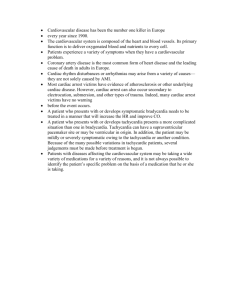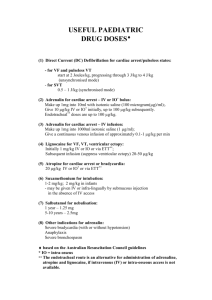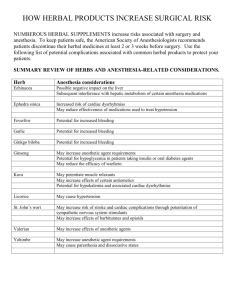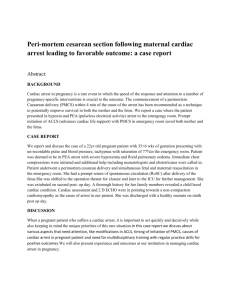September 2007 - Clinical Departments
advertisement
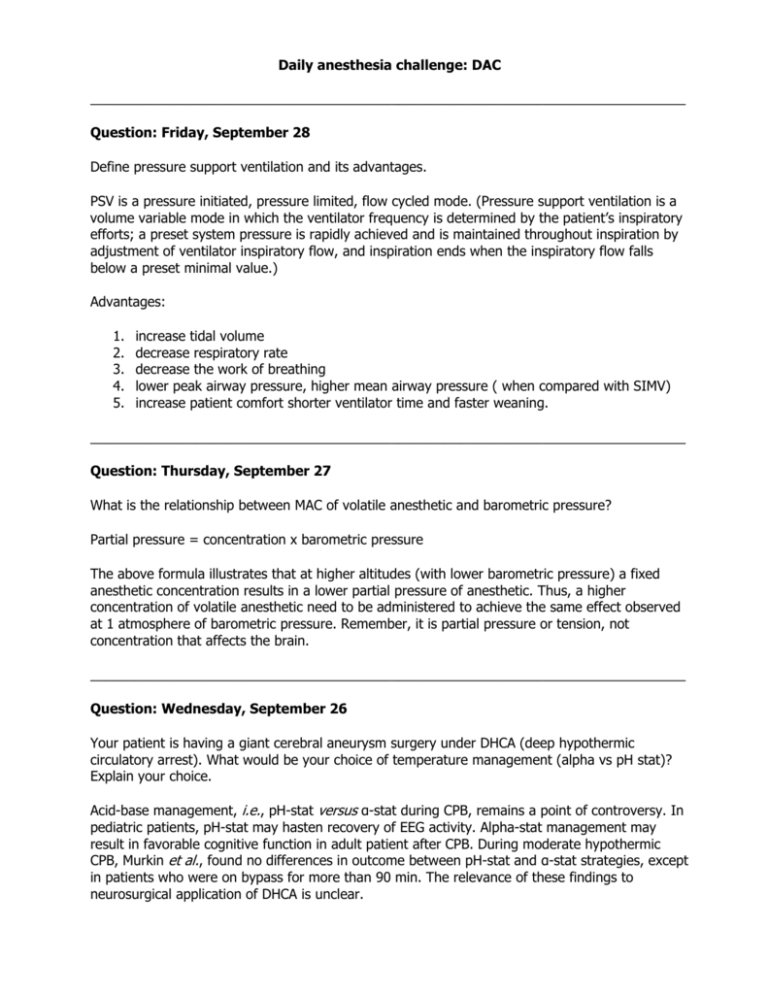
Daily anesthesia challenge: DAC _______________________________________________________________________________ Question: Friday, September 28 Define pressure support ventilation and its advantages. PSV is a pressure initiated, pressure limited, flow cycled mode. (Pressure support ventilation is a volume variable mode in which the ventilator frequency is determined by the patient’s inspiratory efforts; a preset system pressure is rapidly achieved and is maintained throughout inspiration by adjustment of ventilator inspiratory flow, and inspiration ends when the inspiratory flow falls below a preset minimal value.) Advantages: 1. 2. 3. 4. 5. increase tidal volume decrease respiratory rate decrease the work of breathing lower peak airway pressure, higher mean airway pressure ( when compared with SIMV) increase patient comfort shorter ventilator time and faster weaning. _______________________________________________________________________________ Question: Thursday, September 27 What is the relationship between MAC of volatile anesthetic and barometric pressure? Partial pressure = concentration x barometric pressure The above formula illustrates that at higher altitudes (with lower barometric pressure) a fixed anesthetic concentration results in a lower partial pressure of anesthetic. Thus, a higher concentration of volatile anesthetic need to be administered to achieve the same effect observed at 1 atmosphere of barometric pressure. Remember, it is partial pressure or tension, not concentration that affects the brain. _______________________________________________________________________________ Question: Wednesday, September 26 Your patient is having a giant cerebral aneurysm surgery under DHCA (deep hypothermic circulatory arrest). What would be your choice of temperature management (alpha vs pH stat)? Explain your choice. Acid-base management, i.e., pH-stat versus α-stat during CPB, remains a point of controversy. In pediatric patients, pH-stat may hasten recovery of EEG activity. Alpha-stat management may result in favorable cognitive function in adult patient after CPB. During moderate hypothermic CPB, Murkin et al., found no differences in outcome between pH-stat and α-stat strategies, except in patients who were on bypass for more than 90 min. The relevance of these findings to neurosurgical application of DHCA is unclear. On the theoretical level, relatively higher cerebral blood flow with pH-stat might facilitate faster cooling or warming of the brain. Conversely, higher flows and lower cerebral resistance may increase delivery of embolic material to the cerebral circulation. Relatively greater cerebral blood flow may also interfere with brain relaxation, or exacerbate decreased intracranial compliance with the cranium closed. References: 1. Young M, et al. Anesthetic management of deep hypothermic circulatory arrest for cerebral aneurysm clipping. Anesth 2002; 96-2. 497-503 2. Murkin JM: Etiology and incidence of brain dysfunction after cardiac surgery. J Cardiothorac Vasc Anesth 1999; 13:12-7 ______________________________________________________________________________ Question: Tuesday, September 25 A medical colleague suggests considering intraoperative normovolemic hemodilution for your CABG patient. What would be the advantages of doing this procedure? Intraoperative normovolemic hemodilution is the removal of blood through an arterial or venous catheter immediately after induction of anesthesia, prior CPB, or the administration of heparin. Depending of the patient size and hematocrit, 500 – 1000 ml of blood is collected into the blood bags containing CPDA-1 and kept at room temperature. This blood is spared the rigors of CPB, including hemolysis, platelet destruction and clotting factors degradations. The autologous blood is transfused after reversal of heparin with protamine. It has been demonstrated the effect of one unit of fresh whole blood on platelet aggregation after cardiopulmonary bypass is at least equal if not superior to the effect of 8-10 scored platelet units. Normovolemic hemodilution has unique advantages relating to cost, simplicity, and practicality. Although it is safe if performed properly by an experienced team, it is contraindicated in the presence of any coexisting disease that may jeopardize vital organ oxygen delivery. This procedure should not be performed if the anticipated hemodynamic compensatory mechanisms are neither possible nor desirable. References: 1.Van der Linden P et al. Tolerance to acute isovolemic hemodilution: Effect of anesthetic depth. Anesthesiology 2003; 99: 97-104 2. Levy PS et al. Limit to cardiac compensation during acute isovolemic hemodilution: Influence of coronary stenosis. Am J Physiol 1993; 265(Heart Circ Physiol 34): H340-9 _______________________________________________________________________________ Question: Monday, September 24 What are the complications of supraclavicular brachial plexus block? Common side effects associated with this technique include phrenic nerve block with diaphragmatic paralysis and sympathetic nerve block with development of Horner’s syndrome. They usually only require patient’s reassurance. Phrenic nerve block reportedly occurs in about 50% of the time and is not associated with respiratory dysfunction in healthy volunteers. Complications similar to other peripheral blocks, such as intravascular injection with development of systemic local anesthetic toxicity, as well as hematoma formation may occur. Neuropraxia and neurologic injury are similarly possible, but rarely reported. The most feared complication of a supraclavicular block is pneumothorax with rates quoted to be as high as 6.1%. As previously mentioned, this number originates from a paper by Brand and Papper published in 1961. The authors compared 230 consecutive supraclavicular blocks with 246 consecutive axillary blocks. However, the comparison was neither blinded nor randomized and used several different techniques. In contrast, this complication is rare in the modern literature. Reference: Franco, C. Supraclavicular brachial plexus block. www.nysora.com ______________________________________________________________________________ Question: Friday, September 21 Describe how the newborn attempts to maintains its thermal environment. In response to heat loss the infant employs cutaneous vasoconstriction and non-shivering thermogenesis. Non-shivering thermogenesis occurs in the brown adipose tissue. This process is ATP-dependent and leads to a marked increase in the oxygen requirement, placing a further demand on the depressed neonate. The liberation of heat via this mechanism can lead to a metabolic acidosis which may lead to an increase in pulmonary vascular resistance and subsequent revision to a transitional circulation. The neonate should be immediately dried of amniotic fluid and placed under radiant warming lights. The lights should be servo-controlled to avoid burns to the infant. The infant should not be allowed to stay in contact with blankets wet with amniotic fluid for considerable heat loss can occur through the evaporative process. Reference: American Heart Association, American Academy of Pediatrics in the Textbook of Neonatal Resuscitation edited by Leon Chameides and the AHA/AAP Neonatal Resuscitation Steering Committee, 1990 www.theanswerpage.com _______________________________________________________________________________ Question: Thursday, September 20 After the induction of general anesthesia to a 12 years old child ( with Thiopental and Succynilcholine), the patient developed masseter spasm. What is its significance of this occurence? The significance of the occurrence of masseter spasm after the administration of succinylcholine is still debated.Masseter spasm reportedly occurs in approximately 1% of all children receiving succinylcholine (much higher than the prevalence of all neuromuscular diseases combined), whereas in patients with myotonia or other neuromuscular complications, masseter spasm associated with generalized muscle rigidity is a common observation after the administration of a depolarizing agent. Less frequently, masseter spasm is associated with typical MH. Nevertheless, masseter spasm is taken to be an indicator of potential MH, resulting in cancellation of the surgery before hypermetabolism develops. Subsequently, without further information, such a patient and consanguineous family members would be declared MH-susceptible. Although such assumption of MH risk is the safest procedure, it has considerable medical and economic (insurability) implications for the patient. It is most important to perform a careful clinical assessment of a patient who has experienced masseter spasm to determine its cause. The follow-up should include a neurologic examination and the necessary routine laboratory tests to rule out or identify a primary muscle disorder, a muscle biopsy, an IVCT( in votro contracture test), and finally, if indicated, genetic screening. Reference: Iaizzo, Paul A; Lehmann-Horn, Frank.Anesthetic complications in muscle disorders. Anesthesiology:82(5)1995;1093-1096 _______________________________________________________________________________ Question: Wednesday, September 19 If SSEPs change significantly, what can the anesthesiologist and surgeon do to lessen the insult to the monitored nerves? The anesthesiologist can: 1. increase mean arterial pressure, especially if induced hypotension is used 2. correct anemia, if present 3. correct hypovolemia, if present 4. improve O2 tension, correct hypocarbia, if present The surgeon can: 1. reduce excessive retractor pressure 2. reduce surgical dissection in the affected area 3. decrease Harrington rod traction, if indicated _______________________________________________________________________________ Question: Tuesday, September 18 What is the typical coagulation profile of patients with Hemophilia A? Typical coagulation profile of a patient with Hemophilia A demonstrates increased aPTT, decreased clotting activity F VIII level, and normal levels of vWF, IX and XI, PT, bleeding time, and platelets count. _______________________________________________________________________________ Question: Monday, September 17 You are providing anesthesia to a morbidly obese patient undergoing Whipple procedure. Intraoperativelly, the patient develops the right ventricular dysfunction. How would you address the problem? The treatment of RV dysfunction consists of a paradigm aimed at improving O2 delivery by increasing RV preload, direct and indirect augmentation of RV contractility through improving contractility and enhancing coronary perfusion, and reducing RV afterload. Ventilatory strategies are used and are directed at reducing RV afterload and promoting LV filling. The RV is generally less responsive than the LV to inotropic support and therefore may require higher doses of inotropic agents. Epinephrine demonstrates the greatest improvement in RV contractility in animal models. In contrast to the LV, the low-pressure RV receives a significant portion of its coronary filling during ventricular systole, therefore maintaining a normal to slightly elevated systolic pressure maximizes coronary perfusion to the RV and augments contractility. References: 1. McGovern JJ at al. RV contractility and pulmonary mechanics: effects of cathecolamines in an immature animal model of RV injury. Pediatr Res 1996 39:32 A 2. Kern F. et al. right Ventricular dysfunction. In Cardiac Anesthesia – Esthefanous F, Barash PG, Reves JG. 2001 ____________________________________________________________________ Question: Friday, September 14 What are the factors that influence SvO2 value? Several important factors influence SvO2 which must be accounted for when this measurement is interpreted. These factors can easily be understood by deriving the formula for SvO2: answer: SvO2 = SaO2 – (VO2 / 1.34 x CO x Hb) SvO2 is a function of: 1. 2. 3. 4. level of arterial oxygen saturation rate of O2 consumption cardiac output hemoglobin concentration The amount of O2 physically dissolved in blood at normal FiO2 is considered to be a negligible factor in this equation at normal atmospheric pressure. Question: Thursday, September 13 You evaluate in emergency room a patient that suffered a head injury after vehicle motor accident. The patient is breathing spontaneously and has a peripheral pulse. The patient makes incomprehensible sounds, does not open his eyes to verbal command, however with precordial rub, he opens his eyes and tries to reach the chest with his right hand. What is the patient’s Glasgow coma score? Answer: 2 = eyes open to pain 5 = best motor response - localizes pain 2 = best verbal response - incomprehensible sounds Glasgow score: 9 consistent with moderate head injury Question: Wednesday, September 12 What are the potential complications of citrate intoxication in a case of massive blood transfusion? Answer: Metabolic alkalosis and a decline in the plasma free calcium concentration are the two potential complications of citrate infusion and accumulation. Metabolic alkalosis — The pH of a unit of blood at the time of collection is 7.10 when measured at 37ºC due to citric acid present in the anticoagulant/preservative in the collection bag. The pH then falls 0.1 pH unit/week due to the production of lactic and pyruvic acids by the red cells. Acidosis does not develop in a massively bleeding patient even if "acidic" blood is infused as long as tissue perfusion is restored and maintained. In this setting, the metabolism of each mmol of citrate generates 3 mEq of bicarbonate (for a total of 23 mEq of bicarbonate in each unit of blood). As a result, metabolic alkalosis can occur if the renal ischemia or underlying renal disease prevents the excess bicarbonate from being excreted in the urine. This may be accompanied by hypokalemia as potassium moves into cells in exchange for hydrogen ions that move out of the cells to minimize the degree of extracellular alkalosis. Free hypocalcemia — Citrate binding of ionized calcium can lead to a clinically significant fall in the plasma free calcium concentration. This change can lead to paresthesias and/or cardiac arrhythmias in some patients, and decreased cardiac output. Reference: Kleiman S. Massive blood transfusion. 2006, 12. UpToDate. Question: Tuesday, September 11 You have a high index of suspicion that your patient is intoxicated with carbon monoxide. What confirmatory test would you order? Answer: In most patients increased plasma concentrations of carboxyhemoglobin are diagnostic. Venous or arterial blood samples are adequate for measuring the carboxyhemoglobin concentrations which MUST be measured directly with a spectrophotometer. Pulse oximetry cannot distinguish carboxyhemoglobin from oxyhemoglobin therefore the SpO2 is of no value in detecting cellular hypoxia. Calculation of arterial SaO2 from nomograms based on measured PaO2 results in erroneous conclusions. Elevated levels are significant (severe intoxication occurs at levels greater than 40%); however, low levels do not rule out exposure, especially if the patient already has received 100% oxygen or if significant time has elapsed since exposure. Individuals who chronically smoke may have mildly elevated CO levels as high as 10%. Reference: Stoelting R and Dierdorf S. Anesthesia and Co-Existing disease. 2002, 651-653. Question: Monday, September 10 Please choose the correct answer or answers: 1. The child with epiglottitis typically: a. lies on the right side b. has a sudden onset of symptoms c. has a hacking cough d. is febrile 2. The child with laryngotracheobronchitis typically: a. has gradual onset of symptoms b. a barking cough c. a low grade fever d. a subglottic obstruction Answers: 1. a and d. 2. a, b, c, d. Question: Friday, September 7 How do you diagnose fat embolism syndrome (FES)? Answer: In 90 percent of instances, the fat embolism syndrome occurs after blunt trauma complicated by long-bone fractures, but it has also occurred in association with acute pancreatitis, diabetes mellitus, burns, joint reconstruction, liposuction, cardiopulmonary bypass, decompression sickness, and parenteral infusion of lipids. Although it occasionally causes multisystem dysfunction, the lungs are always involved and the brain often is. The diagnosis of the fat embolism syndrome has been based on the physical findings of pulmonary dysfunction as manifested by hypoxemia and tachypnea, axillary and subconjunctival petechiae, and alterations in mental status. Pulmonary dysfunction always occurs and is the first manifestation of the syndrome, usually appearing within 24 hours of the injury. Petechiae develop in 40 percent of patients one to two days later, and 70 percent have changes in mental status. References: Fabian T. Unraveling the fat embolism syndrome. NEJM 1993; 329:961-963 Question: Thursday, September 6 What is vapor pressure of a liquid? Answer: If a pure liquid is enclosed in a container, the vapor above the liquid will exert a pressure --the vapor pressure. Vapor pressure is thus, the force which the molecules of a gas exert on the walls of a container. The saturated vapor pressure is the force the molecules of a gas exert on the walls on a container, when the liquid and gas phases of the substance are at equilibrium, at a given temperature. Vapor pressure depends only on temperature and the specific agent. Vapor pressure is NOT dependent on ambient pressure. Question: Wednesday, September 5 A 39 weeks healthy pregnant patient underwent a continuous labor epidural analgesia for vaginal delivery. Within 10 minutes of placement the patient suffered a cardiac arrest. You are the code leader and you initiate BLS and ACLS protocol. Are there any differences in cardiac resuscitation of a pregnant patient? Explain. Answer: Successful resuscitation in late pregnancy is difficult because the gravid uterus acts like an abdominal binder producing an increase in intrathoracic pressure, diminished venous return, and obstruction to forward flow of blood into the abdominal aorta, especially in the supine position. In addition, the gravid uterus accounts for 10% of cardiac output and this massive shunting of blood may hinder efforts at CPR. External cardiac massage can at best generate only 30% of a nonpregnant patient’s normal cardiac output and increased oxygen requirements during pregnancy make the parturient much less tolerant to hypoxia. To perform chest compressions one must ensure that left uterine displacement is adequately maintained. The Cardiff wedge provides both relief of aortocaval compression and a firm surface upon which to perform compressions. In the absence of a wedge, a “human wedge” is useful by tilting the patient on the bent knees of a kneeling rescuer. Patients can also be “wedged” by using rolled up blankets to tilt the right hip. If the compressions are performed in a hospital bed, the placement of a hard wooden board beneath the patient is also essential for successful compressions. Standard algorithms should be used according to ACLS protocol; they are unaltered by pregnancy. Upon commencement of CPR, one must be vigilant to be sure that time is not wasted if chest compressions and medications are not successful. It is now recommended that cesarean section be performed within 4-5 minutes of the arrest. It has been shown that the shorter the interval between the onset of maternal cardiac arrest and commencement of CPR, and the shorter the time taken to deliver the fetus once CPR commences, the more likely that the mother will survive and the fetus will be neurologically intact. Timing is the most crucial factor when performing CPR in late pregnancy. References: 1. Finegold H. Cardiac arrest in labor and delivery – a current review. SOAP 2007 2. Finegold H. et al Successful resuscitation after maternal cardiac arrest by immediate cesarean section in the labor room. Anesthesiology 2002. 96(5):1278 3. Whitty JE. Maternal Cardiac Arrest during Pregnancy. Clin J Obstet Gynec 2002; 45(2): 37792. Question: Tuesday, September 4 What is heparin-induced thrombocytopenia? Does HITT occur with the use of LMWH? Answer: Heparin induced thrombocytopenia is triggered by antibodies directed against complexes of heparin and platelet factor 4 that form on the surface of platelets and activate their Fc receptors. LMWH cause less activation of platelets and release of platelet factor 4 resulting in the formation of fewer complexes. Therefore, the incidence of HIT is lower in patients receiving LMWH compared to those receiving unfractionated heparin. Reference: Weitz J. Drug therapy: low-molecular-weight heparins. NEJM 1997; 337:688-98.



